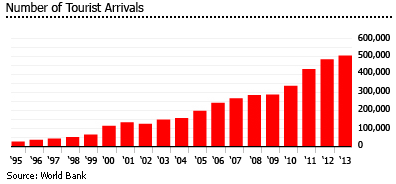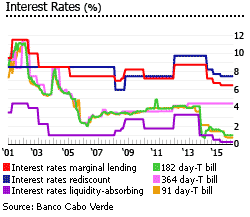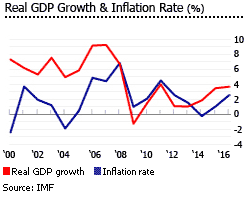Cape Verde: Ebola was a scare, the Zika virus is for real
Cape Verde lives off tourism, and nothing seems to detract from its attractions - not even Ebola. The 2014-15 scare about Ebola in neighbouring West Africa cut the number of hotel guests in Cape Verde by only 2.3% to around 540,000 (and nights spent in Cape Verde fell only 0.6%).
The tourists made the correct judgment - in fact no cases of Ebola were actually recorded in Cape Verde, and by early 2015 tourist arrivals were up by 2% y-o-y, bringing the direct contribution of travel and tourism to Cape Verde's GDP to 15.2%, and its total contribution to 40% of GDP, according to the World Travel & Tourism Council's (WTTC) 2015 report. In Q2 2015, around 116,200 tourists flocked tp the country, a 4.8% increase from the same period last year.
Here comes the Zika Virus
Now comes something more serious: the Zika Virus. On October 21, 2015, the World Health Organization (WHO) was notified of the first reported outbreak of the Zika virus infection in Cape Verde, and by February 6, 2016, the Cape Verde Ministry of Health had recorded around 7,164 cases of the viral infection.
The municipality of Praia on Santiago Island had most cases (4,837), followed by Fogo Island's São Filipe (1,230), and Maio Island (501).
The U.S. Centers for Disease Control (CDC) issued a Level 2 travel alert (Practice Enhanced Precautions) on Cape Verde and other Zika-affected countries in January 2016. Pregnant women, in particular, were advised not to travel in the affected areas. According to Jorge Barreto, a representative of the National Directorate of Health in Cape Verde, the US travel warning was not meant to be a travel ban, but rather a precautionary measure for pregnant women who might want to visit Zika-stricken areas.
Portugal’s “communities portal” also issued a warning travellers to Cape Verde to take all necessary precautions to protect themselves from the Zika virus, signed by health chief Francisco George.
“Cape Verde has historical links with Brazil and it seems very likely it has got there from Brazil,” explained Zika expert Nick Beeching of the Liverpool School of Tropical Medicine.
But the Cape Verdean government is having none of it. “The tourist islands have practically not registered any case” of Zika, said minister for tourism Leonesa Fortes, adding that Cape Verde’s health ministry is working hard to get the republic’s name removed from the danger list. No-one on Cape Verde is believed to have died as a result of infection, and there have been no reports of any babies born with shrunken heads.
It remains to be seen how all this will impact tourism. But with no cure for Zika yet in sight, and the trajectory of the outbreak unknown, things are not looking good for tourism in 2016.
Cape Verde's attractions
Before the Zika outbreak, Cape Verde had overtaken Gambia as West Africa's most popular vacation choice. Unlike some other countries in the region there is hardly any malaria, the climate is consistent year-round, varying from 22 to 30 degrees celsius, there is (comparatively) little poverty and no political or religious strife.
Most visitors to Cape Verde during the first half of 2015 were from the UK (24.2%), followed by tourists from Portugal (13.1%), Germany (12.6%), and France (9.8%).
Sal, known as “the sunniest island” in Cape Verde, receives most tourists, since it houses the country's sole international airport capable of accepting charter flights from Europe. Its hotels accommodate almost half (46%) of total overnight stays in Cape Verde. It has Africa's longest runways, and is undergoing a large amount of infrastructure work, ranging from roads to luxury developments.
Boa Vista island now has around 3,000 hotel rooms, similar to Sal, mostly in the five star category.
Efforts are also being made to encourage vacationers to visit other islands, which include São Vicente with its lively capital Mindelo, the hilly and scenically attractive Santo Antão and the volcanic island of Fogo. São Vicente has seen five new hotels in the past year, immediately followed by Santo Antão and Maio with three and four respectively.
The capital city, Praia, on Santiago Island, is not yet considered a top destination, but the island contains a World Heritage Site and beach facilities are being improved. In mid-2000s, a new airport was also built in the capital to accommodate the influx of travellers, both business and leisure.
"The property market has grown considerably in the last decade, and there’s no sign of it slowing down next year (2016)," said Rich Moore, UK sales director for The Resort Group, in OPP Today, adding that property prices are expected to rise in 2016. "The fact that Cape Verde is experiencing a tourism boom tells us there is a continued demand for holiday rental properties, from private villas right through to beachfront holiday resorts."
Stable politics
Aside from beaches and good weather, Cape Verde has another plus: it is politically very stable. In fact it experienced a near-miraculous journey to Africa's best-rated democracy.
A Marxist one-party state was established following independence in 1975. But in 1991, after pressure for a more pluralistic society, multi-party elections were held. Since then, the then-ruling party (African Party for the Independence of Cape Verde [PAICV]), and the opposition (Movement for Democracy {MpD]) have alternated in government.
Elections are free and fair, the rule of law is respected, and there is press freedom. Freedom House grants Cape Verde rankings of "1" for political rights. and "1" for civil liberties, the only African country with this status. Cape Verdean property law, which derives from Portuguese colonial rule, is one of the best in Africa. Cape Verde maintains close links with Portugal and the Euro zone. Special partnership status has been granted by the EU, and in 2008 Cape Verde joined the World Trade Organization.
Such gains cannot be taken for granted, however. Cape Verde was only in second place, next to Mauritius, in the 2015 Ibrahim Index of African Governance (IIGA). It is also included in IIGA's list of the top ten most deteriorated African countries since 2011. The country totaled 74.5 points, 1.9% lower than in 2011, based on four criteria: Safety and Rule of Law, Participation and Human Rights, Sustainable Economic Opportunity and Human Development.
On March 20 the election of the 72 members of Parliament will take place, the two main contesting parties being the PAICV and the MPD. A new party, the Popular Party, has announced its entry to the election. MPs are elected via proportional representation from 16 multi-member constituencies ranging in size from 2 to 15 seats.
Aside from the 2016 parliamentary elections, Cape Verde's presidential elections will take place in August 2016. President Fonseca (MpD) is aiming for a second term as the country's head of state, and is expected to stand against Prime Minister José Neves (PAICV) for the same position. Both candidates are sensible, technocratic types.
Development continues at a rapid pace
By third quarter of 2016, three new hotels with a total of 1,460 rooms are scheduled to open in Sal namely: Hilton Sal, The Melia Llana Beach Hotel, and Royal Decameron Sal Beach Hotel. The Melia Llana Beach Hotel is projected to have 600 suites, seven pools, four restaurants, a gym, water sports, discos, a Sportsbar, among others. The Royal Decameron Sal Beach Hotel will have two resorts (one four-star and one five-star), with a total of 600 rooms. The Macau Legend Development Ltd. is also poised to build a 152,700 sq. m. tourism complex worth US$ 273 million located in Santa Maria, which will include a casino. It will be competed within three years.

Strong economy forecast for 2016
Growth in gross domestic product (GDP) per capita averaged 7.1% between 2005 and 2008, well above the average for sub-Saharan Africa. From 2002 to 2010, the national poverty headcount rate dropped from 37% to 27%, while the extreme-poverty rate dropped from 21% to 12%.

However Cape Verde did not escape the global financial crisis, which led its economy to contract by 1.3% in 2009. In 2010, the economy slightly gained by 1.5%, followed by a modest recovery of almost 4% in 2011.
The country's economic growth has been slower from 2012 to 2014, with growth of 1.1% in 2012, 1% in 2013, and 1.8% in 2014, according to the IMF.
In Q3 2015, Cape Verde's GDP rose by 1.4% y-o-y, according to the National Statistics Institute (INE), Cape Verde. According to the recent Monetary Policy Report of the Bank of Cabo Verde (BCV), the economy is believed to have grown by 1% to 2% in 2015.
The BCV forecast a better economic outlook in 2016, seeing real GDP growth of 2.5% to 3.5%. However, it seems likely that the arrival of the Zika virus may cause reconsideration of these figures.
Interest rates are moderate

The BCV's marginal lending rate is 6.5%, while the rediscount rate remains at 7.5%. In an attempt to stimulate the economy, the BCV reduced its key interest rate by 25 basis points to 3.5% in February 2015. Reserve requirements were also cut to 15% from 18%.
In March 2014, credit rating agency Fitch Ratings lowered Cape Verde's credit rating by two notches to B from BB-, noting that the accelerating public debt raises the risk of sustaining such debt. Public sector debt stood at 114.7% of GDP by end of 2014, according to the BCV's 2014 Financial Stability Report. Fitch Ratings expects Cape Verde's public debt to rise to around 120% of GDP in 2017.
Loans to non-financial companies fell by 2.2% In December 2014 over the previous year. Meanwhile, private individuals' debt remained stagnant, slightly declining by 0.02%. Mortgage loans, which had the largest share of loans to individuals (70% of total loans to individuals), rose by 0.4%.
The Homes for All Program
Cape Verde has been keen to use the fruits of tourist development to pursue social goals, drawing up a series of measures to promote social housing across the country. In 2009 it formed the Casa Para Todos (Homes for All) Program to reduce the national housing deficit, which now stands at 40,776 dwellings in terms of quantity and 66,013 dwellings in terms of quality.
Subprograms include the Habitar CV Program, which aims to build about 8,496 housing units; the Pro Habitar program to build at about 1,000 homes in rural areas; and Reabilitar to rehabilitate approximately 16,000 households.
In August 2015, the National Political Commission of PAICV announced that the "Homes for All" program will be resumed after the Portuguese authorities gave guarantees to the Cape Verdean government that funds needed for the program's construction work will be disbursed again.
According to the National Political Commission spokesman Moisés Borges, half of the construction projects have already been built. As of August 2015, there were 2,188 apartments ready and the process of property registration hs been concluded. About 843 families are benefitting from the program, which has an occupancy rate of 65%.